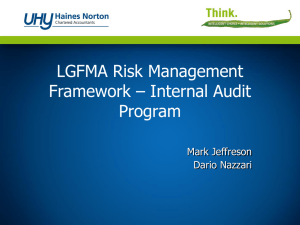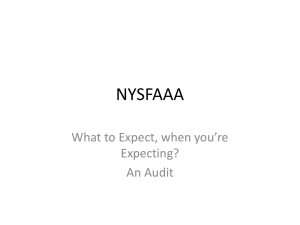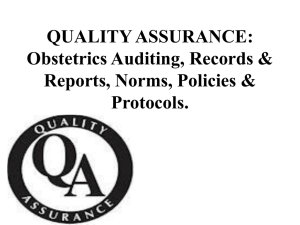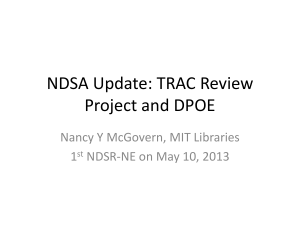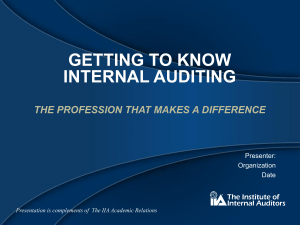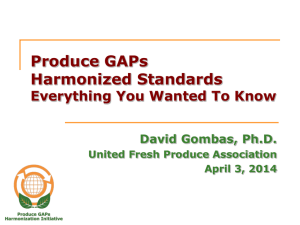GAP Audit Harmonization in North America
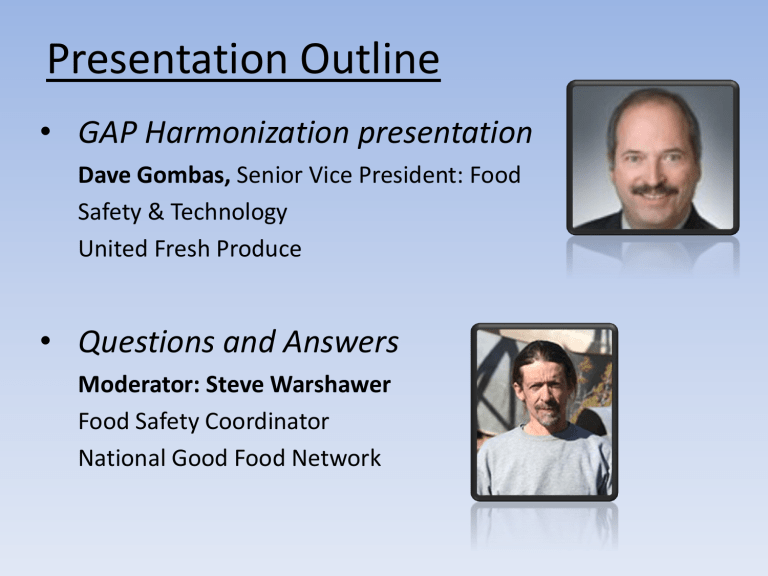
Presentation Outline
• GAP Harmonization presentation
Dave Gombas, Senior Vice President: Food
Safety & Technology
United Fresh Produce
• Questions and Answers
Moderator: Steve Warshawer
Food Safety Coordinator
National Good Food Network
Produce GAPs
Harmonization Initiative
David E. Gombas, Ph.D.
United Fresh Produce Association
September 21, 2010
United Fresh Global Conference on
Produce Food Safety Standards,
April 2009
• Over 200 leaders from each stage of the produce supply chain, government, and thirdparty standard owners and auditors explored the potential value of harmonization and greater alignment of standards
• Produce GAP standards used in various audits in North America seem to be at least 90% the same, providing a clear opportunity for harmonization.
Prior Harmonization Efforts
• Guidance documents (FDA GAPs)
• California Leafy Greens Best Practices
• Food Safety Leadership Council
• SQF 1000 produce standards
• GlobalG.A.P
• Global Food Safety Initiative (GFSI)
Outcomes From the Conference
The process of bringing key stakeholders together to develop and endorse commodityspecific standards provides a good model for building consensus on general GAP standards.
Harmonization of general GAP standards must be transparent with open communication of intent, progress, and conclusions.
Retailers, foodservice companies, fresh-cut processors, grower-shippers, auditors and standard owners, and government must all be at the table working together.
Outcomes From the Conference
Inclusion of non-food safety standards
(environmental, social issues) is a likely obstacle to harmonization, particularly in
North America. These issues may need to be addressed separately.
Process to Harmonization
Identified a small but influential Steering Committee of major industry representatives with the ability to drive broad industry acceptance of common standards:
McDonald’s
Yum Brands
Pro*Act
U.S. Foodservice
Darden
Jack in the Box
Sysco
Subway
Markon
River Ranch
Del Monte Fresh
Taylor Farms
Wegmans
Ahold
Kroger
Loblaws
Safeway
Schnucks
Publix
Walmart
Food Lion
Supervalu
Chiquita Fresh Express
Sun World International
DiMare Company
Green Giant Fresh
Sunkist Growers
Castellini Co.
McEntire Produce
Dole Food Company
The Giumarra Companies
Tanimura & Antle
Costco C.H. Robinson
14 produce associations
Vision of Harmonization
Develop a harmonized food safety standard and checklist for GAP audits, and globallyacceptable auditing process, necessary to protect consumers from potential hazards that may contaminate produce at that stage of the supply chain, and that will build efficiencies into the supplier audit process.
One audit by any credible third party, acceptable to all buyers
Scope of work (1)
A single, generic checklist for GAP audits:
Focused on food safety practices of pre-farm gate produce operations (as defined by the scope of the FDA GAPs);
With clearly defined requirements that minimize opportunity for misunderstanding, misinterpretation and “standards creep” by operations and auditors;
Globally recognized, but specifically applicable to North America operations;
Scope of work (2)
Requirements that are risk-based, sciencebased, attainable, auditable and verifiable;
Considering all microbiological, chemical and physical hazards reasonably likely to occur, consistent with potential hazards addressed in FDA regulatory guidances;
Scalable to all size fresh produce operations;
Considerate of regional- and commodityspecific food safety needs;
Scope of work (3)
Sufficiently non-prescriptive to be accepting of equivalent food safety practices;
Flexible to adapt as science reveals better practices and limits;
Acceptable to a critical mass of customers requiring general produce food safety audits;
Freely accessible by everyone, including any
1st, 2nd or 3rd party auditor.
Technical Working Group
Over 150 stakeholders, representing:
• Customers, suppliers, audit companies, government (FDA and USDA), extension, association staffs;
• A broad scope of fresh produce commodities;
• A broad scope of operation sizes; and
• A broad scope of producing regions, including
Mexico and Canada.
• Open invitation for participation; no stakeholders excluded
Standard Harmonized from
• CA LGMA
• Mushroom GAPs
• SENASICA
• AFDO Model Code
•
•
AIB
CanadaGAP
• Silliker
• USDA
•
•
GlobalG.A.P
SQF 1000
• Tomato Food Safety Audit Protocol
• Community Alliance with Family Farmers
• California Strawberry Commission
Field Operation/Harvest Audit
Standard Draft Now Completed
Categories of the Standard
General Questions
• Management Responsibility
• Food Safety Plan
• Documentation & Recordkeeping
• Worker Education and Training
• Microbiological Sampling and Testing
• Traceability
• Recall Program
• Corrective Actions
• Self-audits
Categories of the Standard
Field Production
• Field History and Assessment
• Worker Health/Hygiene and Toilet/Handwashing
Facilities
• Agricultural Chemicals /Plant Protection Products
• Agricultural Water
• Animal Control
• Soil Amendments
• Vehicles, Equipment, Tools and Utensils
Categories of the Standard
Harvesting
• Preharvest Assessment
• Water/Ice
• Containers, Bins and Packaging Materials
• Field Packaging and Handling
• Postharvest Handling
Transportation (Field to Packinghouse)
• Equipment Sanitation and Maintenance
Post-harvest Operations standard
• General Questions
• Produce Cooling
• Packinghouse
• Transportation (from Packinghouse)
• Produce Storage
Fast Facts about the Standard
• 84 audit items
• 14 written policies/procedures, such as
– Food safety plan
– Traceability and recall programs
– Toilet, worker hygiene and health policy
– Water management plan
• 14 types of records, including
– Training records
– Soil Amendments
– Agricultural Chemicals
– Pre-planting and pre-harvest risk assessments
– Microbiological testing (if performed)
What makes it scalable?
• Worded to work for family operations as well as large corporate farms, diverse crop farms as well as single commodity operations
• Allows for “not applicable”
• Requires designation of responsibilities, not dedicated personnel
– Allows, does not require, hiring outside personnel, within the limits of the law
• Requirements, documents, records generally simpler with fewer employees, smaller operations
• Most often instructs auditor to look at practices rather than written procedures or records
Audit Standard
Audit Process
Audit
Audit Process
• Operations Committee commissioned to develop policies and procedures for use of the harmonized standard
• Standard will be freely usable by any audit organization, but must be used consistently
• Market will decide which audit process is most credible, acceptable
Next steps
• Complete the Post-harvest Operations audit standard (Costco, Oct. 21-22)
• Schedule “pilot” audits using the draft standards:
– Operation, auditor, customer
– Different commodities, different size operations
– Assess what works, what doesn’t, and make changes to the draft
• Develop auditor training tools
What does this mean for you?
• Decreased number of audits
– Multiple customers willing to accept the same audit means fewer audits
• Consistent expectations
– Auditors (and customers) using the same standard should be asking the same questions, judging compliance the same way; less “moving target”
• Reduced audit costs
– Focus resources on operation, not on passing the audit of the day
What you can do
• Review the standard and tell us: What’s not clear? What doesn’t work for your operation?
• Use the standard for your own self-audit
• Ask your customers – are they involved in the Initiative? What do they think about it?
• Participate. The Initiative was created to help reduce your audit burden while harmonizing food safety expectations.
Make sure it works for you.


